Amazon’s SERP Variations: How Amazon Search Results Work

Most sellers and marketers think of the Amazon search results page (SERP) as static: a list of products ranked mostly by keyword relevance, reviews, and price.
However, in reality, Amazon's SERP is a dynamic ecosystem that changes constantly based on query type, shopper intent, device, category, and even user history.
If you’re still viewing the Amazon SERP through a one-size-fits-all lens, you’re missing out on the nuances that can give you a strategic edge.
This article isn't about how to rank #1. It’s about how to study and understand the different SERP formats, behaviors, and triggers, and how Amazon tailors the shopping experience depending on context.
Once you see the variations, you’ll start to spot patterns. And once you spot patterns, you can build smarter strategies, whether you're launching a new product, planning ad spend, or analyzing competitors.
Understanding the Different Types of Amazon SERPs
The Amazon SERP morphs based on multiple factors. Let’s break down 8 core dimensions that drive these variations and what you should be paying attention to in your own SERP studies:
1. Featured Content & Modules
Amazon often features different types of content and modules depending on the search query.
Amazon’s Choice/Best Seller Badges:
For high-volume or highly competitive keywords like "wireless headphones," you will often see the Overall Pick or Best Seller badge. Amazon highlights products that it deems highly relevant for the query.

However, for more niche searches such as "vintage typewriter," these badges might be missing.
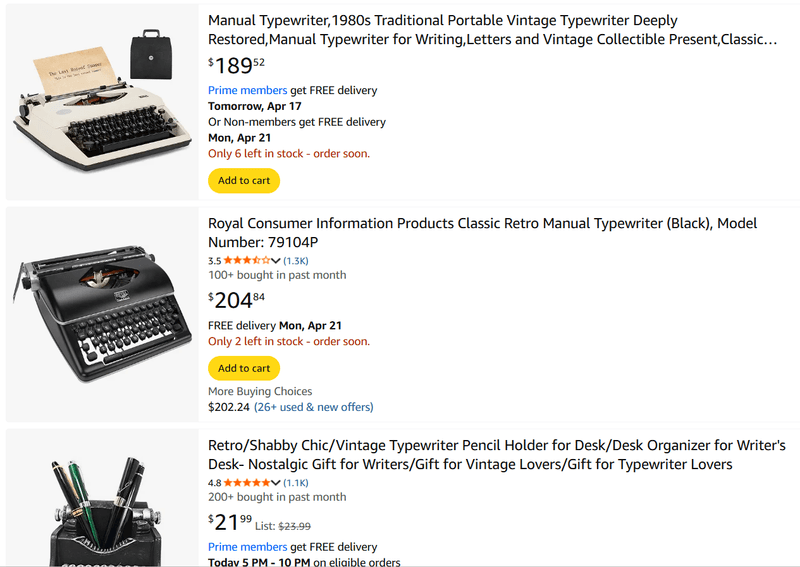
Sponsored vs. Organic Listings:
If you're searching for high-intent products like "iPhone charger," you may see several sponsored listings at the top.

2. Dynamic Filter & Sort Options
Filters and sort options vary across categories and can be influenced by factors like product type and pricing.
Category-Specific Filters:
When searching for "laptops," you will likely see filters for specific categories such as RAM size, screen size, or processor type. You will also see the Popular Shopping Ideas column in left which shows different types of laptop.
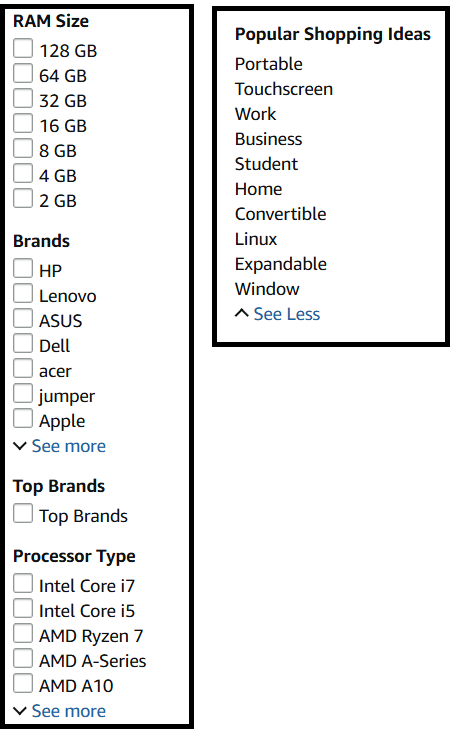
But when searching for "dresses," Amazon might offer filters for things like color, length, and size.
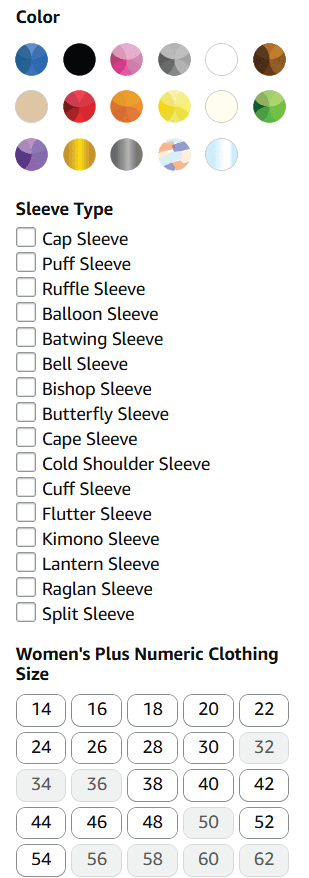
3. Category-Specific Attributes
Different product categories will highlight distinct attributes depending on what is most important for the product type.
Tech Specs:
A search for "Bluetooth speakers" will focus on specifications like power outputs, connectivity options, and water resistance.

Groceries:
When searching for "organic coffee," Amazon will likely emphasize certifications (such as USDA Organic) and even details about the flavor profile (e.g., smooth, bold).

Books:
For books, Amazon’s SERPs highlight the genre, language, and condition, This offers a glimpse of important information before users click through to the product page.
4. Brand Visibility & Ambiguity
Brand-centric queries and ambiguous product names also create unique SERP variations.
Brand-Centric Queries:
If you search for "Nike running shoes," brand filters and a prominent brand-specific carousel will still show other shoe brands. This holds true for the queries like "samsung watch."
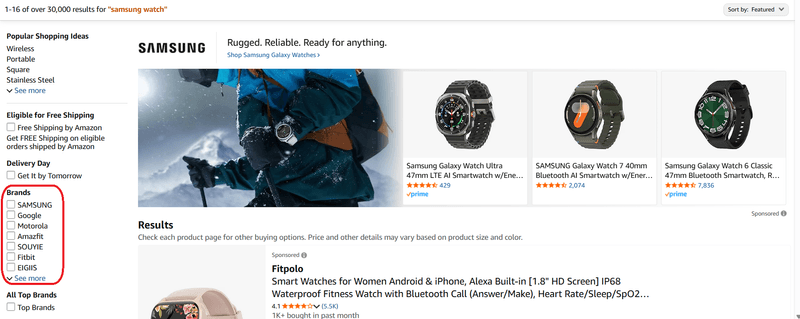
If you filter by adidas brand in "Nike running shoes" query, it will show adidas running shoes.
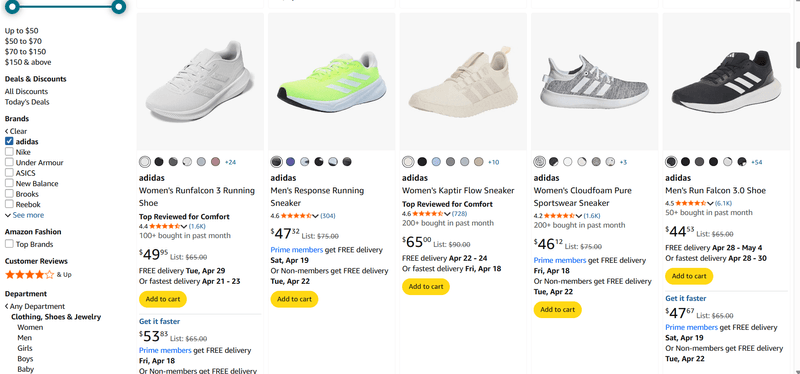
Ambiguous Terms:
When searching for "Apple," the results will likely show a mixture of tech products (like Apple iPhones) and fruit-related items (like fresh apples). Amazon might use distinct images to visually differentiate the two categories.
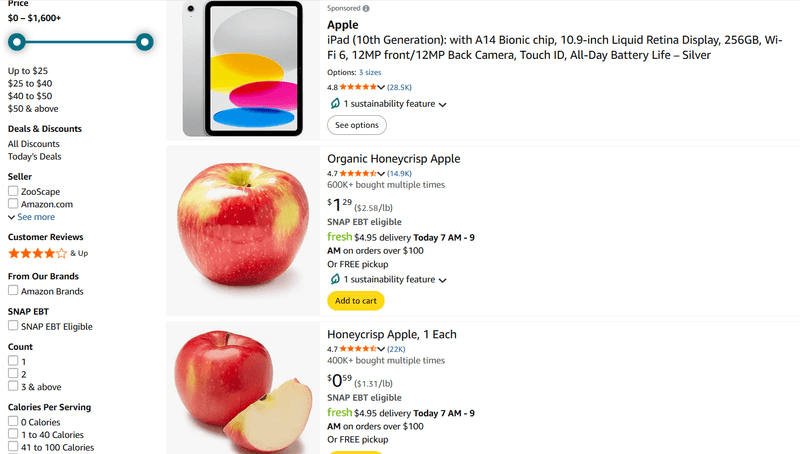
5. International & Regional Variations
Localization plays a major role in shaping how products appear on Amazon’s SERPs in different regions.
Localization:
If you search for "green tea" on Amazon Japan, the search results will likely feature local Japanese brands such as ITOEN.
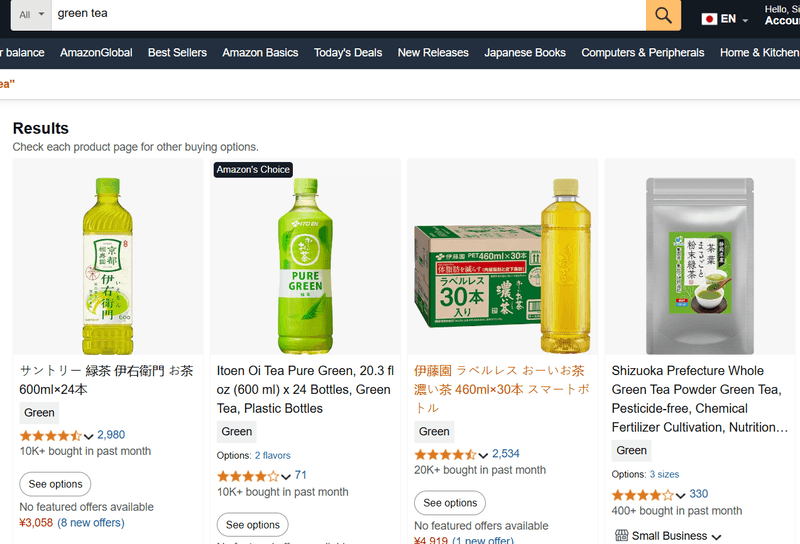
On Amazon’s US site, you'll likely find a mix of international brands.
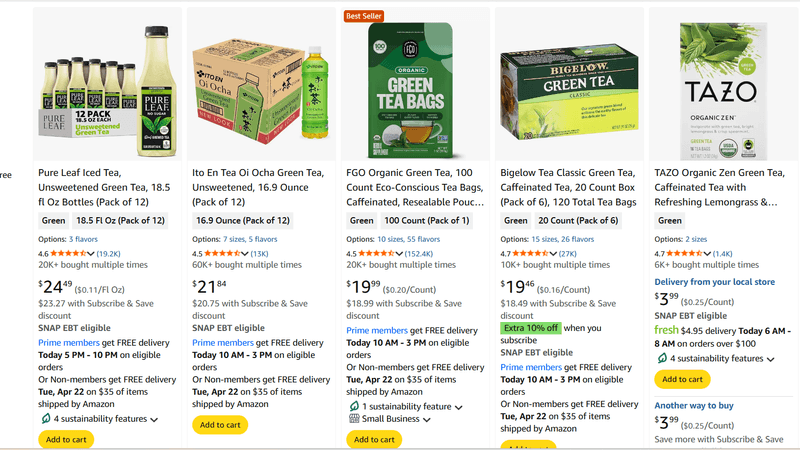
Currency/Units:
Pricing will display in local currency and sometimes different measurement units. For example, Amazon UK might show product weights in kilograms, whereas Amazon US might list it in pounds.
6. Personalization & User History
Personalized results based on a user's browsing and purchasing history are commonly featured on Amazon.
Tailored Results:
If you’ve recently bought fitness gear, searching for "protein shakers" might show personalized recommendations that prioritize products in line with your past purchases.
Wishlist Influences:
Items that are on your wishlist, such as "board games," may appear more prominently in your search results for relevant queries.
7. A/B Testing & Seasonal Trends
Amazon continuously tests different layouts and promotional modules.
Layout Experiments:
For some query ("backpacks"), some users might see product results in a carousel format, while others may see a grid layout. This helps Amazon experiment with what works best for different customers.
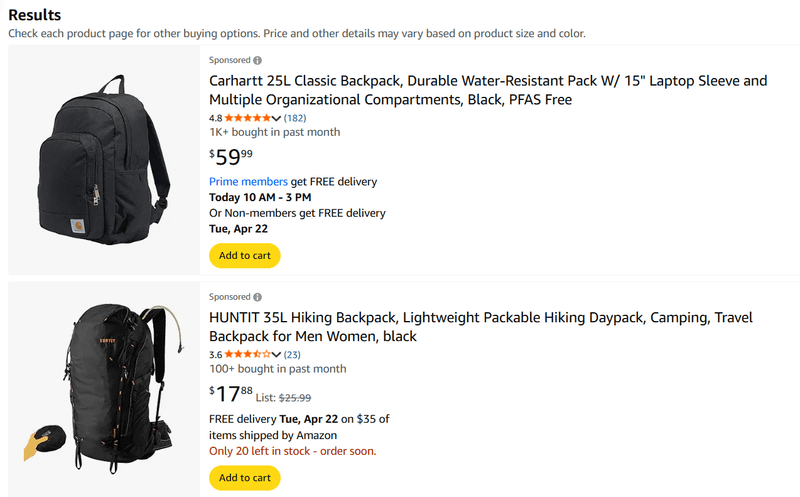
Holiday Banners:
During the holiday season, searches for common gift items might display modules like "Gift Guides" or "Festive Deals" for added convenience.
8. Types of Queries & Search Intent
The type of search query a shopper uses greatly affects the layout and contents of the Amazon SERP. Amazon dynamically adjusts modules, filters, and even ranking weight depending on whether the query is broad, brand-specific, or niche.
-
Generic Queries: Searches like “backpack” or “laptop” tend to trigger the most diverse SERPs with a mix of sponsored placements, and a broad range of brands and price points.
-
Long-Tail or Specific Queries: More detailed searches such as “leather backpack for travel” or “budget gaming laptop under $700” tend to display fewer sponsored listings and more relevant organic results, with filters closely matching the user’s specific needs.
-
Brand Queries: Searches like “Adidas sneakers” usually prioritize branded stores, banners, and filtering tools that narrow results to products under the brand umbrella. But it is not always true as we seen in nike running shoe example above.
Why Studying SERPs Matters More Than Ever
Too often, brands chase rankings or ad placements without truly understanding the behavior of Amazon’s search experience. But the SERP is where the customer journey begins and studying it yields critical insights:
-
Spot emerging competitors: See who's consistently showing up for your target terms
-
Understand Amazon's priorities: See which features (videos, carousels, badges) are emphasized for your category.
-
Detect shifts early: Amazon frequently tests new formats. If you notice a new module on a SERP, it might be a sign of a broader rollout to come.
Go Beyond the SERP with Deeper Data
Studying Amazon’s SERPs gives you context, but pairing that with real-time product data takes your strategy to the next level.
With tools like Unwrangle, you can extract structured insights like reviews, ratings, pricing, brand info, and listing details across thousands of products. It’s a powerful way to understand not just what shows up in search, but why.
If you're looking for ways to how to use market research to guide your e-commerce decisions, or looking to extract Amazon product or review data, check out these guides:
